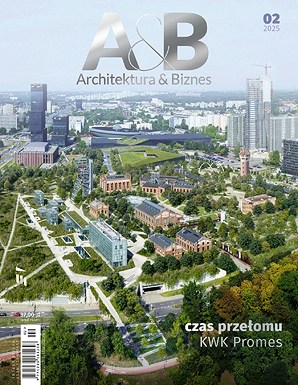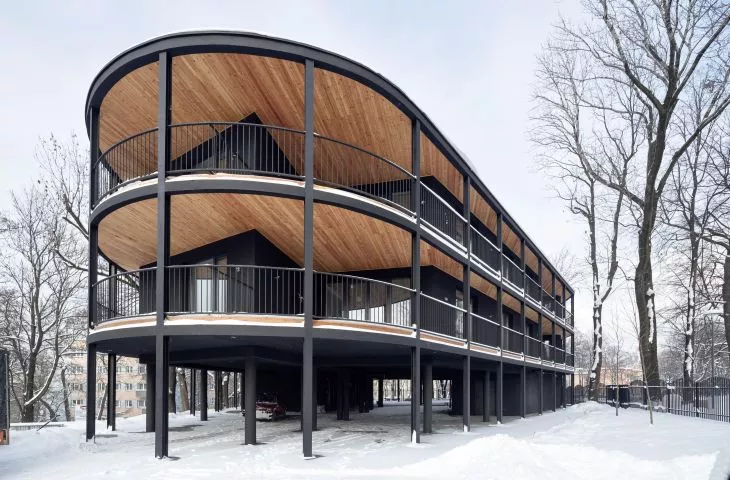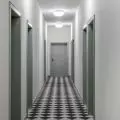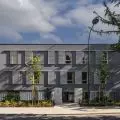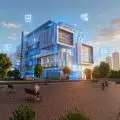Villa Reden is a new development by Maciej Franta of the Franta Group studio built on Mount Reden in Chorzow, Poland. The multi-family building with a black façade and light wood elements refers to the surroundings and history of the area.
Villa Reden is a building housing eight apartments
Photo: Tomasz Zakrzewski © Franta Group
historic neighborhood
Villa Reden is located in an area full of greenery, old architecture and remnants of mines. The apartment building on the north side is adjacent to a dark wooden church moved here in 1935 from Knurów. In the distance, the post-industrial Sztygarka complex and the historic concrete President hoist shaft are visible. The surroundings of the former mine now serve recreational and park functions and continue the green corridor of Reden Park and Silesian Park. On the other hand, on the east side there is an oversized water reservoir, a former air raid shelter. Constructed in raw concrete and overgrown with greenery, the structure perfectly camouflages itself in its surroundings and provides a backdrop for the new apartment building. On the south side of Villa Reden, there is a historic building of a former park restaurant, turned into an office. Very important in this location is the existing greenery, as well as the neighborhood and the character of the interwar buildings on the west side, which makes up the bulk of the neighborhood.
The building is located on Mount Reden in Chorzow
Photo: Tomasz Zakrzewski © Franta Group
The context of the site and the potential negative consequence of implementing new fabric into this unique area meant that the decision to shape the new building was not easy and had to directly relate to these guidelines. It also had to fit into the existing tissue in a contemporary way, and above all not compete with it. The task was all the more difficult because the budget was limited and the investor's expectations were high," says Maciej Franta.
The villa was built on a plan similar to a triangle
© Franta Group
unusual body
The form of the building is a direct result of the polygonal irregular terrain and the desire to preserve the trees on the plot. The architects first formed the polygonal mass according to the function of the apartments. Then they determined the perimeter line along the contour of the plot boundaries and surrounded the block with balconies and terraces of varying areas to open up the view to the surroundings. Rounded corners allude to the character of interwar villas in the neighborhood. In the next step, a patio was introduced and the residential part was raised by one story, leaving the first floor undeveloped. In the final phase, the architects shaped the vertical divisions of the facade to form expressive regular squares.
Villa Reden is a building of small scale
Photo: Tomasz Zakrzewski © Franta Group
The building is an object of small scale and does not have very varied solutions. Its basic feature is a modest and consistent selection of finishing materials and a simple and inexpensive way of construction. Such assumptions we tried to meet in accordance with the investor's expectations. Of course, the final effect is the result of confronting our assumptions with dynamic changes on the site, a rather long construction period and various unforeseen circumstances," adds Maciej Franta.
eight apartments
The villa, which looks like a single apartment building, was designed as a complex of four two-story residential buildings divided into four independently functioning parts with a total of eight apartments. The first floor of the building is mostly empty space serving as a common area for all residents, as well as a building entrance area with technical rooms. Each section has an independent entrance in the form of a staircase that leads to two units. Each unit is designed to have access to a terrace of varying widths along the outer perimeter, as well as to a patio that further illuminates the apartment entrance areas and bathrooms.
The building was recognized by the jury of the Paris Design Awards 2021 and won in the Residential Architecture category.
Residents enjoy terraces and a common area on the first floor
Photo: Tomasz Zakrzewski © Franta Group
Dobrawa Bies: What was your priority in this project?
Maciej Franta: The context and the immediate vicinity of the trees, which, in spite of the current "developer tendencies," we considered an asset of the plot, not a problem. They are the ones intended to build the impact of the building and create such a natural aura around the building. Residents have huge terraces, to which they have access from every room in the apartment, and from these terraces they can touch these trees with their hands - a closer relationship with the surrounding nature could probably not be achieved.
Dobrawa: What did the investor expect?
Maciej Franta: The investor expected an architecturally interesting building, but also a viable investment. He is also passionate about contemporary architecture, so his level of confidence in our ideas was high.
The elevation of the villa refers, among other things, to the historic church
Photo: Tomasz Zakrzewski © Franta Group
Dobrawa: The building is distinguished by its unusual facade and rounded body. What was the inspiration and what is the source of the object's shape?
Maciej Franta: It is a confluence of two ideas. The varied shape of the building is also the result of the varied shape of the plot - the walls of the building reflect the boundaries of the plot. Its rounded corners are forms based on curves and organic shapes, which we can observe in the immediate surroundings in the form of trunks and tree crowns.
Dobrawa: Please tell us about the materials used and construction solutions.
Maciej Franta: The building was realized in traditional brick and reinforced concrete technology and the terraces were made in an independent steel structure - this gave us the opportunity to finish the facade in an interesting and authentic way, in the form of nice and even rhythms of verticals and levels.
The challenge was also the selection of a suitable matte black paint
Photo: Tomasz Zakrzewski © Franta Group
Dobrawa: What posed the greatest design difficulties for you, and what are you most proud of?
Maciej Franta: We managed to achieve all of our goals - to convince the investor to take a bolder approach to the project, to tie the building to its surroundings, to inspire and create architecture for which the definition of sustainable design is more than just technology, to define a viable function in relation to the resources spent, and most importantly to achieve a fresh and interesting result. It seems to us that this building "sits" very well in its location, and its idea is very unusual and definitely different from the emerging residential buildings. The most important thing, of course, is that we are receiving information that it pleases both architects, residents and the neighborhood. I hope that it will positively settle down for years to come and will be an interesting point on the map of Chorzow's architecture.
Dobrawa: Thank you for the interview.
